|
The Month in Photos!
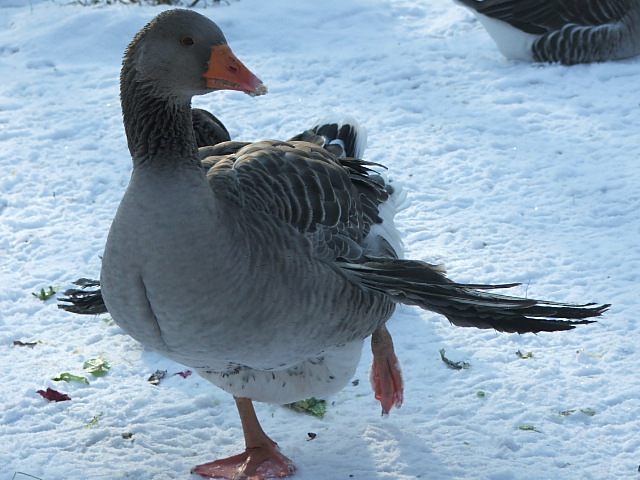
Angelo our little airplane...
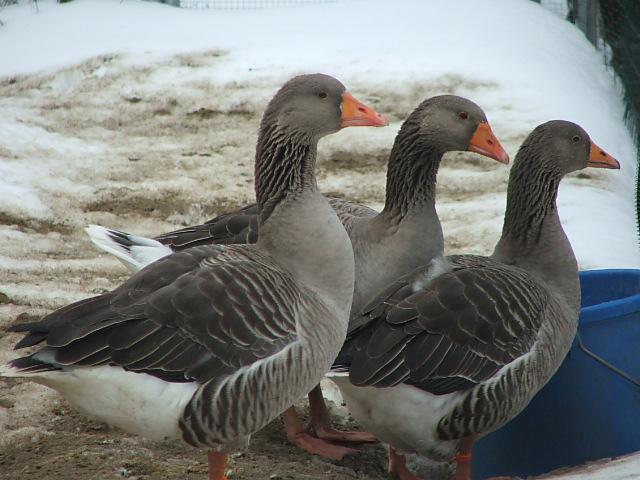
Trio:
Bunky, Angelo & Pretty Girl
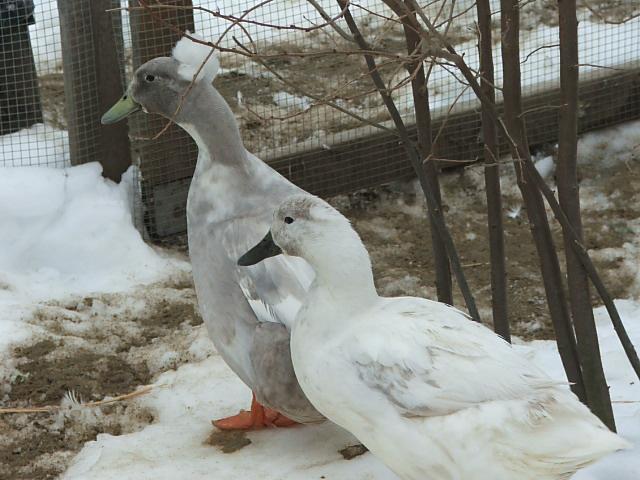
Asaru & Tiwana in the snow
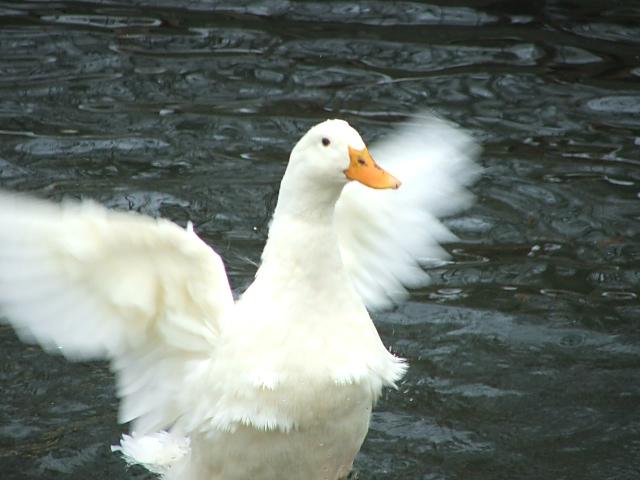
Aladdin strikes a pose!
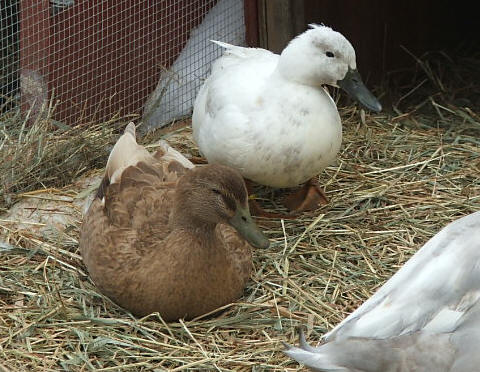
Daisy May & Tiwana
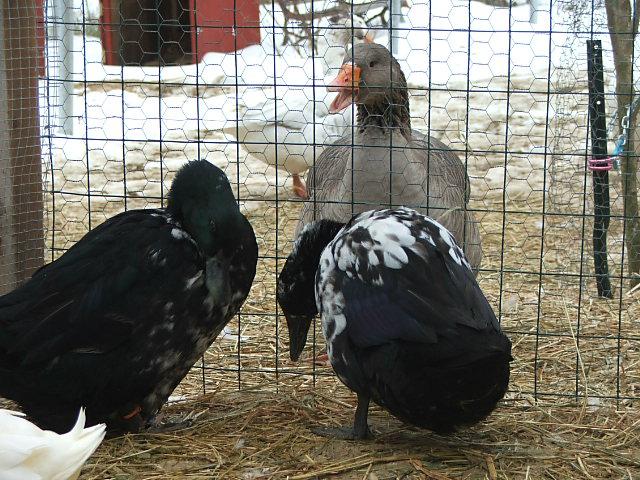
Bowie has a chat with Merry & Pippin
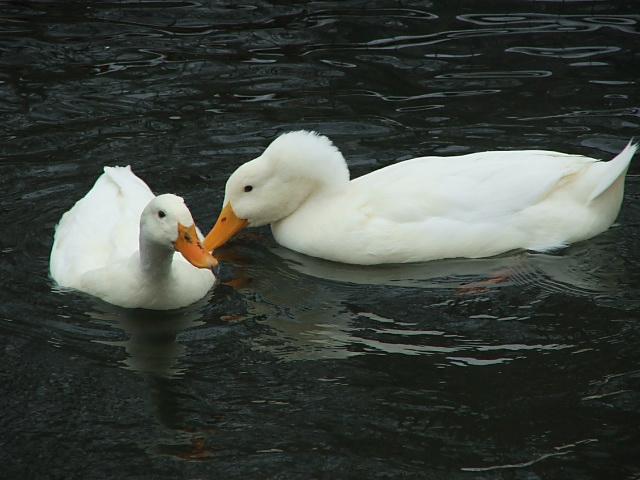
Jasmine & Aladdin... A kiss...
Adopt or Sponsor!
If you are a loving
family and have a predator proof pen, please consider adopting! Click here to fill out our
online adoption
application.
If you can’t adopt, please consider sponsoring
by visiting our
sponsor page.
Recommended
Reading*

The Perfect Nest
Product
Description
Jack the cat is building the perfect nest.
It’s bound to attract the perfect chicken, who will lay the perfect
egg, which will make the perfect omelet.
And sure enough, a chicken shows up, but so
do a duck and a goose . Feathers get ruffled — and Jack gets much
more than breakfast — in a funny tale rich in detail with a sweet
final twist.
Click
here
to order.
|
* |
For
our full recommended reading list, click
here. If you order from
Amazon by way of our website, Majestic receives a
portion of the proceeds! |
Contact Us
Majestic Waterfowl
Sanctuary
17 Barker Road
Lebanon, CT 06249
directorATmajesticwaterfowl.org
Our Newsletter
The Majestic Monthly is published 12 times per year.
Previous issues are available in our
Archives.
|
Catching &
Handling Waterfowl
In order to avoid
injuring your duck or goose, it is important to know how to
catch and handle them. Friendly birds typically do not need to
be caught; for these feathered friends you can just lift them up
and hold them or set them on your laps. But for those of you out
there who have shy or aggressive flock members, there may be
times when you need to handle them. You should be able to catch
and hold any member of your flock at the drop of a hat. This is
imperative in the case of medical emergencies; it is also
helpful when performing worming, delousing or leg banding.
Ducks and geese have
fragile hips and legs. Never catch them by the legs or
you risk breaks, sprains and dislocations. Further, when
cornering them in their pen, be very careful not to run them
over or through any dangerous obstacles (holes, rocks, pools or
other objects). Slowly ease them to the section of their pen
that will allow for easy and safe capture.
Geese:
When picking up a
goose, it is easiest to scoop them up. Put your dominant arm
behind their body and slide one hand under their bottom and
forward between their legs. Lift the goose up into your arms.
One of the wings will be pressed safely against your torso. Put
your free arm under their belly to help support the weight of
the goose, and use that hand to hold the other wing in place--to prevent
it from
flapping. If your goose is a bit feisty, you can use your
non-dominant hand to gently hold them by the neck—do not
squeeze. You can limit their range of motion and prevent being
bitten by holding your hand high up on their neck.
When catching a goose
that is not accustomed to being held, you can corner them in an
area of their pen and catch them with one hand around their neck—loosely.
Do not squeeze. While they are dealing with this distraction,
follow the instructions above and quickly put your other arm
underneath them and between their legs. Now you can pick them
up. It is best to have a helper when dealing with a goose that
is not used to handling. An assistant can help keep the goose’s
outer wing safely tucked in.
When you lift a
domestic goose up without supporting their legs, they do not
have the leverage they need to power their huge wings. Although
people tend to fear their open bill, we find their wings are
more likely to cause serious injury if not properly controlled.
Bites can be serious and even draw blood, but it is pretty easy
to dodge a bite—especially if wearing gloves. Being hit with a
fast and repetitive flapping goose wing can cause serious
bruising and can even break bones.
When dealing with
aggressive or fearful geese, it is always wise to wear
protective clothing, including leather gloves, a thick jacket
and blue jeans. Keep striking zones in mind when attempting to
catch a goose that is not tame. A goose will typically strike
that part of your body which is closest to them. Make sure your
face is not their primary target. Approach them from the side or
back—not head on. Keep your hands extended out in front of you.
Stand up straight; do
not make your approach on a goose while bent over or leaning
forward. If a goose is going to strike, you want them to hit
your arms or legs. If you are about to catch a goose and it
strikes at you be very careful not to pull your arms back
reflexively or you may expose your face to the attack. Remember,
arms forward, face held back. Use your arms and hands to deflect
a bite and then grab the goose’s neck with your other hand. You
can either scoop them up at this point, or squat down over them
to hold their wings safely in place.
Keep in mind, if a
goose strikes and latches onto your protective clothing, they
are immediately vulnerable to capture. They are distracted and
their bill is closed, seize them by the neck and scoop them up
or squat down over them.
It can be
very helpful to have a partner who distracts them while you come
up behind them to grab them and scoop them up.
If you have an
aggressive goose in your flock, an occasional capture and lift
will boost you to the top of the pecking order. As an alpha
leader, your goose will not act aggressively towards you, but
will respectively move out of your way.
Ducks:
Picking up a duck is
much easier than a goose, because they aren’t nearly as
aggressive, and they are a lot smaller. Their wings aren’t as
powerful and the inside of their bills have little combs as
opposed to jagged edges. If a duck bites you or hits you with
their wing, it may sting a bit, draw a dot of blood, or bring on
a small bruise or scratch, but these are worst case scenarios
and are not common, especially with proper handling.
If your duck is used
to being handled you can just pick them up by placing your hands
over their body—one hand on each side, the way you would pick up
a cat. Once in your arms, you can support their feet.
If your duck is not
used to being handled, you will need to corner them in their
pen. Then, pick them up the same way as a goose: scoop them up
from the back with one hand under their body and between their
legs. Do not support the legs to avoid wing flapping and toe
nail scratches. Keep one wing pressed against your torso and
restrain the other with your free hand.
Unless you have a very
aggressive duck, you will not need to place a hand on their neck
at any time during catching or handling. If you do have a biter
on your hands in lieu of holding their neck it would be wiser to
just wear a sweatshirt or jacket. Protective clothing will
prevent them from their trademark pinch & twist strategy
to get you to let them go.
Farewell Beautiful
Sebastian...
Our hearts are with
you, Sharon, during this trying time. It is so hard to let go of
our dear feathered friends. You made Sebastian's life so perfect
and a happier duck she could not have been, and that is entirely
because of you. Rest in knowing that she is forever happy and
will always look down upon you with complete love and without a
single regret.
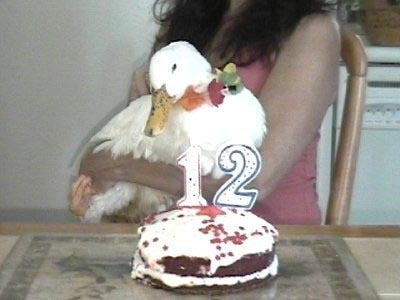
Click
here to read Sharon &
Sebastian's story.
Our Dear
Tutter-Tut
Sadly, our Tutter lost his ability to walk very suddenly on the
Saturday before Christmas. An x-ray revealed that he has either
bone cancer or a bone infection in his left knee joint.
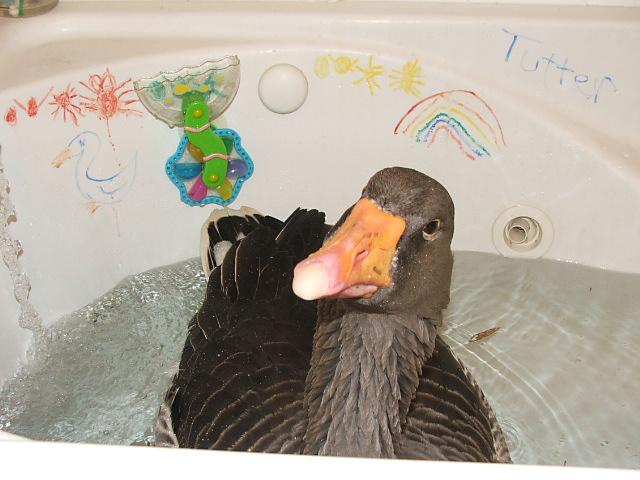
Tutter is on antibiotics and
anti-inflammatory medication. He is resting comfortably in our
basement infirmary where we can check on him frequently and
carry him upstairs to the tub for warm baths. We had a few warm,
sunny days, so we brought him outside for a few hours to be with
his best friend Angelo. Visits with his good friend always lift
his spirits.
Tutter is responding well to his medication, but we will not
know the true nature of his affliction until he goes back to the
vet for a follow up, comparative x-ray.
Special thank you to
Dr. Poster of
Poster Animal
Hospital, Dr. Melgey of
All Friends
Animal Hospital
and to
our good friend Caroline for helping me hold my heart together
and keeping me focused.
To Make a
Donation...
If you would like to help support the special needs members of
our flock, like Tutter and Glory, click
here to make a donation.
|

